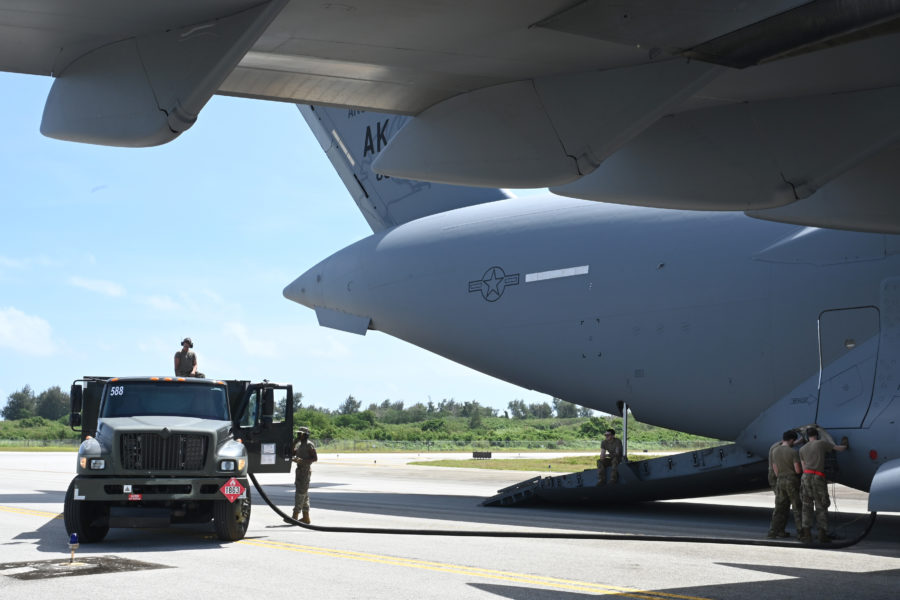Gas is king in the vast expanse of the Pacific. And as the Pentagon has sought to build up its capability to deter China, the Department of Defense has undergone a major rethink about how to get fuel to the region.
At the heart of the effort is U.S. Transportation Command (TRANSCOM), which recently assumed responsibility for the global management of the U.S. military’s bulk fuel.
“We need to make sure we can assuredly move that fuel and get it to where it needs to go,” Air Force Gen. Jacqueline Van Ovost, the commander of TRANSCOM, said June 6 during a Brookings Institution event.
Under the previous arrangement, the responsibility rested with the Defense Logistics Agency’s Energy office, which traces its history back to the Army-Navy Petroleum Board set up in World War II. The decision to transfer the mission to TRANSCOM was directed by the 2022 National Defense Authorization Act and officially authorized by President Joe Biden in April.
TRANSCOM’s new responsibility, Van Ovost explained, “allows us to put our TRANSCOM expertise of command and control and planning and posture to ensure that we can actually deliver that fuel wherever and whenever we need it.”
Van Ovost said her command has already conducted wargames with the Air Force and other services to make sure the U.S. military can be properly supplied.
“We also need to relook where our fuel posture is to meet the requirements,” she added.
The Air Force is seeking to dramatically expand its overseas infrastructure spending in its fiscal 2024 budget, including for fuel. The service’s doctrine of Agile Combat Employment, or ACE, is based on a “hub and spoke” presence of logistics, and fuel for aircraft will have to come from somewhere.
“The whole big picture purpose of ACE is to disperse your forces, so that’s exactly what we’re going to do during a conflict, which is we’re going to have jets spread out,” Gen. Kenneth S. Wilsbach, the commander of Pacific Air Forces, said in March. “To sustain that force for periods of time does take additional logistics.”
Much of the fuel will need to be sent by sea. Van Ovost noted the Pentagon has stood up a maritime tanker security program under which the U.S. military will be able to access medium-range Merchant Mariner vessels during a conflict. Arrangements to use 10 of those ships have already been nailed down, she said.
But that’s just part of the puzzle. To get to the far-flung islands the Air Force and other services may be operating out of, the U.S. military will also need access to different types of ships.
“We’re working on the next 10 as well to be able to assuredly move fuel inside the first and second island chain—more shallow draft vessels that we didn’t have before,” Van Ovost said.
TRANSCOM, which normally operates behind the scenes, has been thrust into prominence as it has moved massive amounts of military materiel to Europe as part of America’s aid to Ukraine and the repositioning of the U.S. personnel and equipment on the continent to reinforce NATO.
However, TRANSCOM’s longer-term focus remains to modernize to deter China and support service efforts such as new Air Force concepts developed under Chief of Staff Gen. Charles Q. Brown, Jr.
“Our competitors are on a trajectory that will provide really persistent threats across all domains, and that’s why the services are changing their service concepts and you’re seeing more maneuver in their concepts,” Van Ovost said. “As I think about the maneuver concepts, I have to be able to integrate into Gen. Brown’s Agile Combat Employment.”
Across other services, the Marines want to refashion themselves as an island-hopping force with advanced anti-ship weapons. The Army, meanwhile, is planning to deliver a punch with long-range fires. But it is TRANSCOM that will coordinate the massive logistical undertaking to sustain America’s military, whether by sea, land, or air—military or civilian-owned.
Prior the assumption of her current role, Van Ovost led Air Mobility Command. That force, which comprises around 500 tankers and 500 airlifters, will be called upon to help build out bases and move American forces around in the Pacific.
Van Ovost highlighted the age of America’s roll-on, roll-off transport ships and Air Force tanker fleet, based largely around KC-135s that date back to the 1950s, as requirements that will require a continued overhaul.
“We need to recapitalize out into the future with things that are going to be able to withstand contested environments,” Van Ovost said. “Those are just some areas that I’m concerned about, but we’re getting after it or we’re mitigating the risks, and we’re doing a lot of exercises and making sure that our people are ready.”
